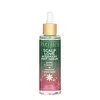What's inside
What's inside
 Key Ingredients
Key Ingredients

No key ingredients
 Benefits
Benefits

 Concerns
Concerns

 Ingredients Side-by-side
Ingredients Side-by-side

Water
Skin ConditioningPanthenol
Skin ConditioningRosmarinus Officinalis Leaf Extract
AntimicrobialAscorbic Acid
AntioxidantAloe Barbadensis Leaf Juice
Skin ConditioningHyaluronic Acid
HumectantSpiraea Ulmaria Flower Extract
Skin ConditioningHamamelis Virginiana Extract
AntiseborrhoeicSalvia Officinalis Extract
AntimicrobialTussilago Farfara Leaf Extract
AstringentAchillea Millefolium Extract
CleansingMelilotus Officinalis Extract
AstringentGlycyrrhiza Glabra Root Extract
BleachingThymus Vulgaris Extract
PerfumingEquisetum Arvense Extract
AstringentHydroxyethylcellulose
Emulsion StabilisingSodium Benzoate
MaskingPotassium Sorbate
PreservativeParfum
MaskingWater, Panthenol, Rosmarinus Officinalis Leaf Extract, Ascorbic Acid, Aloe Barbadensis Leaf Juice, Hyaluronic Acid, Spiraea Ulmaria Flower Extract, Hamamelis Virginiana Extract, Salvia Officinalis Extract, Tussilago Farfara Leaf Extract, Achillea Millefolium Extract, Melilotus Officinalis Extract, Glycyrrhiza Glabra Root Extract, Thymus Vulgaris Extract, Equisetum Arvense Extract, Hydroxyethylcellulose, Sodium Benzoate, Potassium Sorbate, Parfum
 Reviews
Reviews

Alternatives
Ingredients Explained
These ingredients are found in both products.
Ingredients higher up in an ingredient list are typically present in a larger amount.
Parfum is a catch-all term for an ingredient or more that is used to give a scent to products.
Also called "fragrance", this ingredient can be a blend of hundreds of chemicals or plant oils. This means every product with "fragrance" or "parfum" in the ingredients list is a different mixture.
For instance, Habanolide is a proprietary trade name for a specific aroma chemical. When used as a fragrance ingredient in cosmetics, most aroma chemicals fall under the broad labeling category of “FRAGRANCE” or “PARFUM” according to EU and US regulations.
The term 'parfum' or 'fragrance' is not regulated in many countries. In many cases, it is up to the brand to define this term.
For instance, many brands choose to label themselves as "fragrance-free" because they are not using synthetic fragrances. However, their products may still contain ingredients such as essential oils that are considered a fragrance by INCI standards.
One example is Calendula flower extract. Calendula is an essential oil that still imparts a scent or 'fragrance'.
Depending on the blend, the ingredients in the mixture can cause allergies and sensitivities on the skin. Some ingredients that are known EU allergens include linalool and citronellol.
Parfum can also be used to mask or cover an unpleasant scent.
The bottom line is: not all fragrances/parfum/ingredients are created equally. If you are worried about fragrances, we recommend taking a closer look at an ingredient. And of course, we always recommend speaking with a professional.
Learn more about ParfumRosmarinus Officinalis Leaf Extract comes from rosemary. Rosemary is native to the Mediterranean.
While Rosmarinus Officinalis Leaf Oil can be volatile due to its fragrant properties, the fragrance components are usually removed in the leaf extract.
Rosemary Leaf Extract contains many antioxidants such as rosmarinic acid and caffeic acid. Rosemarinic acid, a compound found in rosemary leaf, has been found to help soothe skin conditions such as eczema and acne.
Learn more about Rosmarinus Officinalis Leaf Extract